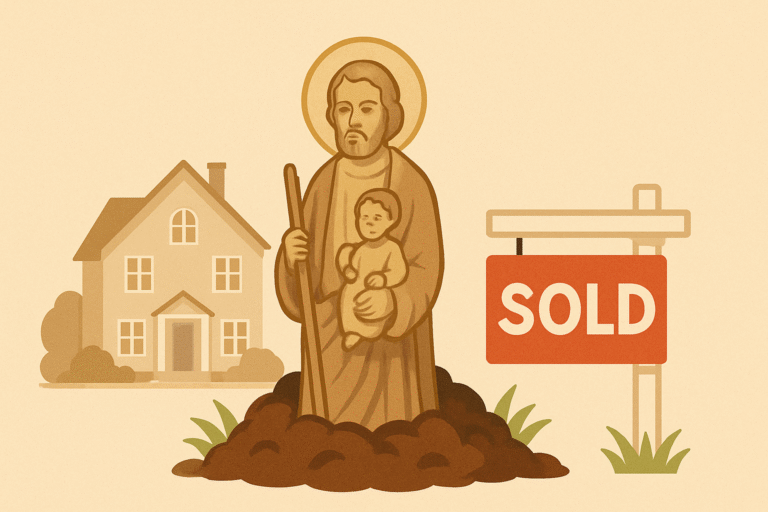
Selling a home can be stressful, especially when it sits on the market longer than expected. In search of every possible advantage, some homeowners turn to a centuries-old Catholic tradition: burying a St. Joseph statue in the yard. This practice is believed to bring divine help in selling a house faster. But where did this tradition come from, and does it really work?
While not everyone believes in spiritual rituals or religious symbols, the St. Joseph statue has become a popular charm among sellers hoping for a little extra luck. From anecdotal stories to real estate forums, many people share experiences of successful sales after turning to this small act of faith.
In this article, we’ll explore the origins of the St. Joseph home-selling tradition. Also, how it’s typically done, and what both believers and skeptics have to say. Whether you’re religious or simply curious, understanding this unique ritual may offer new insight. Or at least a conversation starter—as you navigate the real estate process.
The Origin and Meaning of the St. Joseph Statue Tradition
The tradition of burying a St. Joseph statue to help sell a home is rooted in Catholic beliefs. St. Joseph, the earthly father of Jesus, is known as the patron saint of workers, families, and homes. He represents stability, protection, and guidance—qualities that make him an ideal figure to call upon during life’s major transitions.
The practice reportedly began with European nuns or monks centuries ago. In times of need, they would bury medals or statues of St. Joseph on land they wished to acquire or sell, praying for divine intervention. Over time, this custom evolved into today’s more commercialized version, where miniature plastic statues are sold in real estate-focused kits.
Despite the lack of official recognition by the Catholic Church, the tradition has gained popularity among both religious and non-religious home sellers. For many, it’s less about dogma and more about hope and ritual. It offers a sense of control and faith during the uncertainty of selling a home.
Whether viewed as a spiritual act or symbolic gesture, the St. Joseph tradition taps into our desire for support—divine or otherwise—during pivotal life moments.
How the Ritual Works: Steps for Burying the Statue
The St. Joseph statue ritual is a well-known tradition among some home sellers who hope to speed up the sale of their property. While it may seem superstitious, many people find comfort and motivation in following this process. The practice is rooted in Catholic beliefs but has been adopted by people of various backgrounds who are simply looking for a bit of extra help.
To begin, you’ll need a small statue of St. Joseph—usually around 3 to 4 inches in height. These statues are widely available through religious supply stores and online retailers. Once you have the statue, the next step is to bury it in the yard of the home that’s for sale. The most common tradition is to bury it upside down, facing the house, near the “For Sale” sign or by the front yard. The upside-down placement is symbolic, believed to motivate St. Joseph to help you leave the home quickly.
After burying the statue, many people recite a specific prayer asking for St. Joseph’s help. One popular option is the Prayer to Sell a House, which seeks his intercession and blessing. The prayer is usually repeated daily until the house sells.
Once the sale goes through, tradition holds that the statue should be unearthed and taken to the new home. Placing the statue in a position of honor is seen as a gesture of thanks. While not a guaranteed method, the ritual may offer hope and a sense of control during what can be a stressful process.
Looking for more conventional advice? Our guide on selling your home quickly for cash provides effective strategies backed by market trends.

Does It Actually Work? Faith vs. Reality
Whether burying a St. Joseph statue truly helps sell a house is a question of faith, perspective, and personal experience. Many homeowners who’ve tried the ritual report positive outcomes. For some claim their homes sold faster than expected, while others say it gave them peace of mind during a stressful process.
However, there’s no scientific evidence that the statue itself causes a home to sell. Real estate experts often credit other factors—such as proper pricing, marketing strategy, and property condition—for the final sale. Still, even professionals acknowledge that belief and mindset can play a role in how sellers approach the process.
In truth, the ritual may function as a form of psychological encouragement. It gives sellers a sense of hope and focus, especially when combined with prayer or reflection. Having something symbolic to believe in can create a more positive mindset, which could indirectly influence decision-making and persistence.
For deeply religious sellers, incorporating faith into the process aligns with their values and beliefs. Others might see it as a harmless tradition—one that adds a personal touch to an otherwise transactional experience. Either way, the ritual is unlikely to harm your chances of selling and might even bring comfort.
Curious how to boost your home’s appeal with proven methods? Don’t miss our resource on what home appraisers look for. It offers valuable insights that complement both spiritual and strategic selling tactics.
Final Thoughts: Tradition Meets Strategy
Burying a St. Joseph statue is more than a quirky tradition—it’s a meaningful ritual for many home sellers rooted in faith and history. While there’s no guarantee that the statue alone will sell your home, it may offer emotional reassurance and a sense of control during an unpredictable process.
The key takeaway is this: combining faith-based practices with solid selling strategies can offer the best of both worlds. If you choose to bury a St. Joseph statue, don’t forget the basics—price your home correctly, present it well, and work with an experienced real estate agent who understands the local market.
At the end of the day, whether the statue serves as a spiritual anchor or a hopeful symbol. It reflects the personal nature of selling a home. For some, it’s a comforting tradition. For others, it’s a last-ditch effort when the process stalls. Either way, it won’t hurt to try—and it just might bring the results you’ve been hoping for.
For more on how home-selling rituals compare to modern strategies, visit this balanced overview from Realtor.com’s take on St. Joseph statues.



